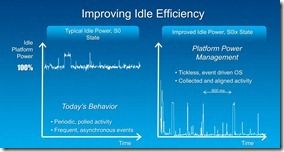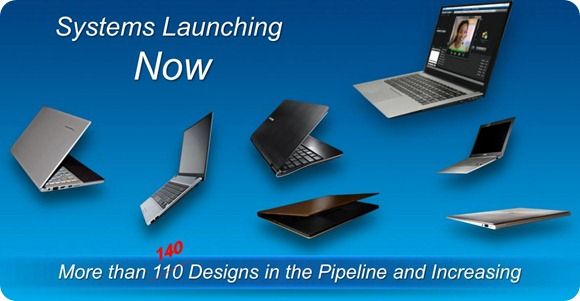Netbooknews has just published some information they’ve had from Intel during a chat with Navin Shenoy, the President of Intel Architecture Group and General Manager of the Mobile Client Platform. Most of the information wasn’t anything new but there’s a hint towards back-to school offers. As we were expecting, back-to-school offers will be starting in August and real sales numbers will start to show.
We’re expecting 140 Ultrabooks globally and this figure has been re-iterated. 35 designs are already in the market apparently. We have 65 Ultrabooks in our database so they must be talking Ivy-Bridge models here. Again, 140 is a huge number, huge growth figure and shows commitment from all manufacturers, except Apple!
40 designs will have touchscreens with Windows 8. That tallies with previous figures given by Intel which also said that 12 would be convertible designs.
Intel say that August sales figures will show growth, especially because some back-to-school offers are planned. Intel can’t subsidize the cost of Ultrabooks but you can be sure they’ll find a way round that by paying for marketing, cash-back and other offers. We’re expecting $599 offers soon so check back with us regularly for more information. Sidenote: The Acer S3 is $650 today at Amazon.com
Intel are continuing to say that $699 will start to make entry-level Ultrabooks more attractive. We hope that isn’t for last-gen or Core i3-based current models though. Some of those Ultrabooks are already available for that price.
 Finally, Intel gave Netbooknews a little teaser about Haswell, the first SoC (Single On-Chip) platform for Ultrabooks and PCs – 20X less idle power than Ivy Bridge. That’s the S0ix state Intel have been talking about. We estimate that to be good enough for Windows 8 AOAC, something in the region of 200mW. We’ll be getting more information on Haswell in September when we attend the Intel Developer Forum.
Finally, Intel gave Netbooknews a little teaser about Haswell, the first SoC (Single On-Chip) platform for Ultrabooks and PCs – 20X less idle power than Ivy Bridge. That’s the S0ix state Intel have been talking about. We estimate that to be good enough for Windows 8 AOAC, something in the region of 200mW. We’ll be getting more information on Haswell in September when we attend the Intel Developer Forum.
The full article, in German, is available at Netbooknews.de












Having 40 ultrabooks with touch is nice but only 12 (globally) of these are convertible. I would think it would be a much higher percentage. I’m having a hard time conceptualizing how I would use touch on a day to day basis in a non-convertible (std laptop) usage mode. Have you tried/tested touch in this configuration? how does it compare to using a slate?
Battery life on haswell is going to be insane then?
Idle battery life will be huge. (Screen off, connected)
As always with an architechture change, expect 20% performance increaase for the same battery life under load or 20% more battery life under load.
The average battery life, in my estimate, could go up by 30% in most cases, more with usage cases where the device can go idle a lot.
Note, screen backlight in idle scenarios is likely to account for over 50% of power usage so the trick is going to be to get that backlight down or off ASAP.
I’ll try and write this up in more detail for you as soon as i’ve come back from IDF in Sept where I expect to get more detailed info and some of my questions answered.
Chippy
Insane? Well, that is always a relative term. However, Haswell is expected to bring battery life enhancements that is normally seen in multiple generation gap.
2013 platforms are supposed to feature displays with lower panel and circuitry power, and features Panel Self Refresh(PSR) technology which alone is supposed to bring 500mW in power savings.
The key difference in Haswell and previous architectures in power management is that while previous platforms improved only CPU-side power, Haswell improves power management across the entire platform.
In idle, you are going to see 3W screen + 3W platform power in current generation reduced to 2.5W screen and <150mW. Before, it would have addressed CPU side power management which may have reduced platform side power by 100-200mW or so.
I hope most of them will have a Thunderbolt port. Considering it’s Intel’s technology, the almost total lack of availability is frustrating.
I personally think Intel have a hard job to do to promote Thunderbolt. Accessories are very high-end and expensive and don’t match consumer-level Ultrabooks.
USB3.0 is doing a good job of interconnectivity and even additional screens. Only external GPUs are missing with the USB3 tech.
Chippy
The problem is that they have (for whatever misguided reason) been marketing TB as a port, where it’s more of a docking cable. USB3 struggles with high-bandwidth applications – even a single external SSD can bump into its ceiling.
What’s the difference between Haswell’s upcoming AOAC & the Mac’s new feature “Power Nap”?
Are these new technologies when the machine wakes up at predetermined intervals to check for updates or do they work the same way as ARM-based devices?
Haswell’s feature works the same as in Tablets and Smartphones, and its similar to the new Power Nap feature in Mac. The difference is that Sandy Bridge and Ivy Bridge does not allow such low idle power to allow true Alway on, Always Connected scenario, and the Power Nap is currently limited by that. So the current Power Nap devices have to wake up periodically.
I assume Mac OS’s Power Nap, and Intel’s Smart Connect will all be updated when Haswell arrives.